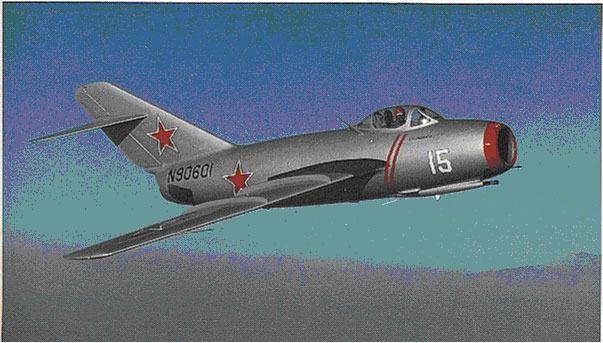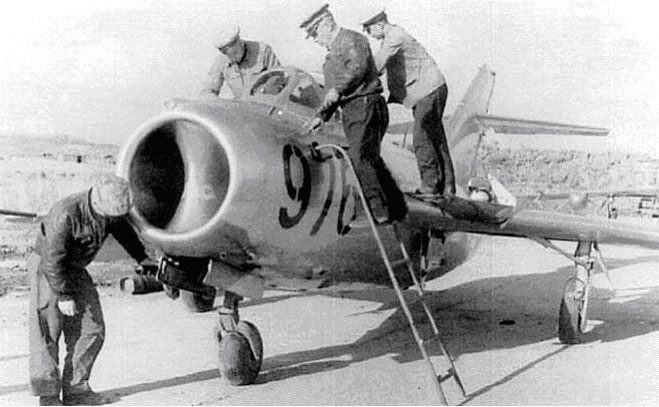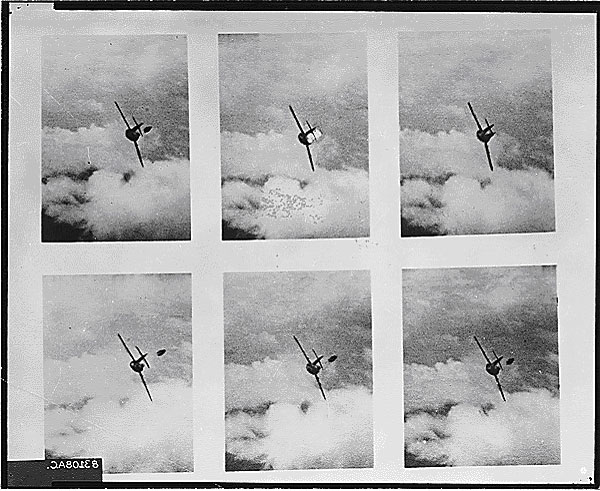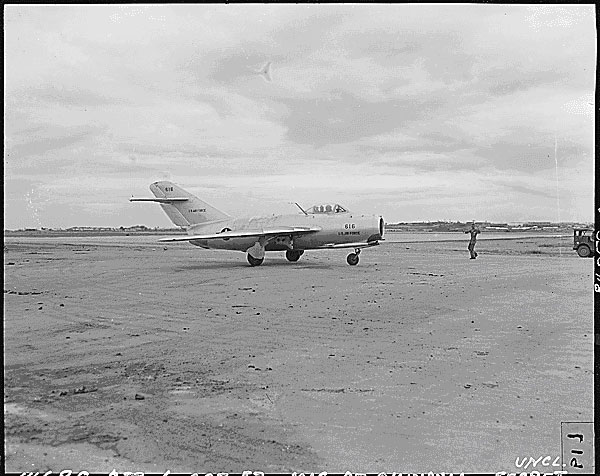


A MiG-15
history
by Earl Swinhart

Mikoyan-Gurevich MiG-15
On November
30, 1950, at 0720 hours (local) during a raid on the North Korean Air Base at
Namsi, an American B-29 Superfortress was hit by cannon fire from an
aircraft that flashed by so fast, the gunners had no chance to return fire.
Luckily the damage was confined to the outer port wing of the Superfortress
and it immediately turned back toward its base. F-80C "Shooting Stars"
which were escorting the B-29' stried to engage the interloper but were
left in the dust as the stranger turned northeast toward the Yalu River. The
Americans had not even had time to identify the nationality of the craft, and
though a couple of F-80 pilots got a fleeting glance at the silhouette,
intelligence officers at the debriefing were unable to identify the craft
except to say it was jet powered. F-80 pilots estimated the craft was
approximately 85 mph (136.8 kph) faster than the Shooting Star. Damage to the
B-29 indicated the craft carried at least one 37mm cannon and probably
another, smaller cannon. This was the debut of the "MiG-15" and USAF brass
viewed the development with what was described as "organized panic", from
Korea all the way to the Pentagon.
In 1939, Anushavan Ivanovich ("Artyom") Mikoyan and Mikhail Iosifovich
Gurevich teamed up to enter a design competition for a new Russian monoplane
fighter. They won the competition and their outstanding MiG-1 design was put
into production by the TsKB (Central Constructor Bureau) and the
Mikoyan-Gurevich Design Bureau was formally recognized by the Soviet
government in early 1941.
The close of WWII found Russia with an abundance of captured German aircraft
technology. There were experiments in high speed and near sonic speed flight,
which the German scientists were unable to put to practical use due to allied
bombing and the subsequent deterioration of facilities. There were captured
Messerschmitt Me-262 and Arado Ar.234 jet aircraft along with many brand new
Jumo and BMW jet engines, still in crates. Everything including scientists,
experimental data, engines, aircraft, tools and machinery was immediately
confiscated, loaded into boxcars and shipped to Russia. This action put the
Mikoyan-Gurevich Design Bureau in possession of mounds of secret German
documents and the scientists who had created them.

The
introduction of the MiG-15 was a total (nasty) surprise to the NATO air
groups, somewhat comparable to the surprise the Allies received when the
Japanese A6M Zero-Sen made its appearance a few years before, during
WWII. The Mig-15 was developed under the utmost security. The Soviet
philosophy was; if another country could achieve military superiority, sooner
or later it was bound attack Russia, just as the Nazis had on June 22, 1941.
Under Stalin, military weapons research had high priority and the secrecy
involved was deadly serious. Anyone even suspected of the slightest security
violation was tortured and executed. The KGB was listening. Thus, the MiG-15 -
arguably the worlds best fighter aircraft at the time - was produced in near
total secrecy.
The first step toward producing the first MiG jet was known as the model
I-250. It featured the odd installation of a 1,400 hp (1045 kW) piston engine
in the front and a small, 650 pound static thrust (2.89 kN) jet located in the
rear. The craft itself was vaguely reminiscent of the sleek MiG-1 with a
rather sharp nose, and cockpit set into the back half of a bullet-shaped
fuselage. It was said this oddball craft had a top speed of well over 500
miles per hour (805 kph) in level flight, placing it in the elite group of the
fastest prop driven planes in the world.
Though the goal was to produce a pure jet aircraft, Russia simply did not have
the engineering expertise to build a jet engine capable of enough power to
better the speed of a prop driven plane. Like the US a few years before, the
Soviets in 1944 were working with technology acquired from building
turbochargers for piston engines. It is (very roughly) a similar problem
designing a jet engine as designing a turbocharger; extremely hot exhaust
gases under pressure are used to power a turbine. In front of this turbine
(connected the same shaft) is a compressor which packs fresh air and fuel into
a combustion chamber. Upon ignition, the hot gasses are produced which power
the turbine, thus producing a self sustaining reaction and (in the case of the
jet engine) the thrust needed to power the aircraft. The first practical
Soviet jet powered aircraft was the Mig-9 which flew on April 9, 1946. It had
a top speed of 560 mph (901.23 kph) which was much faster than the prop driven
aircraft of the time, but not faster than the American P-80A Shooting Star
(the designation "P" for "Pursuit" was changed in 1948 to "F" for
"Fighter").

Ejection of a MiG Pilot -- This
unusual sequence of photos, taken by gun camera film of a U.S. Air Force F-86
"Sabre" jet fighter-interceptor, shows a Communist MIG-15 pilot abandoning his
aircraft after it has been hit by the "Sabres" gunfire.
(Photo: National Archives
and Records Administration)
While the
Soviets were having their developmental problems, the British on the other
hand seemed to be years ahead of everyone. The Jumo and BMW engines the
Russians had captured in Germany were rather primitive when compared to
England's Rolls-Royce jet engines in the late part of 1945. And just as it
appeared the rest of the world was about to leave the Soviets far behind in
the race for a more practical jet engine, fortune truly smiled on the Reds.
In Britain, Clement R. Attlee of the socialist Labor Party was elected Prime
Minister in 1945. Attlee, being somewhat naive about the Russian brand of
socialism, immediately set about improving relations between Britain and
Russia. At the invitation of Attlee, Joseph Stalin sent a team of scientists
and engineers to the Rolls-Royce factory to study the design of the superb "Nene"
jet engine. Arrangements were made for the Soviets to manufacture the engine
in Russia under license from Rolls-Royce. They also took several Nenes with
them when they returned to Russia. The Russians wasted little time in copying
every detail of the engine and appropriating the design as their own, calling
it the "Klimov RD-45" with no regard at all being given to the licensing
agreement with Rolls-Royce. However, due to the quality of the Russian
materials used in construction of the RD-45, performance of the engine left
much to be desired. Turbine blade failures were common, and average time
between overhauls was on the order of a very few hours. Fuel consumption
bordered on the intolerable. The dogmatic approach of the Soviet aircraft
industry solved these problems one-by-one and eventually produced an engine of
nearly equal quality to the original Nene. It was called the Klimov VK-1 -
still almost an exact copy of the Nene.

Hq. FEAF, Tokyo --- With reassembly and ground checks completed, a MIG is taxies to take-off position by a U.S. Air Force test pilot on Okinawa. The Russian-built fighter was flown by five Air Force pilots. The F-86A-5 Sabre had inferior performance when compared to the MIG-15. However, the superior training and tactics of the US pilots had established a "kill ratio" of better than 8:1 over the MIG. (Photo: National Archives and Records Administration)
Now in
possession of a powerful and reliable jet engine, work was resumed on the
design of a suitable airframe. The "I-310", as the super secret
Mikoyan-Gurevich craft became known, was first flown in late 1947 and it was
immediately obvious to the Russians that they had a "world beater" on their
hands. There were still some flaws to be eliminated, but it possessed dazzling
performance.
Throughout the late forties, development proceeded on the I-310. Different
combinations of cannon were tried, The final arrangement being two 23mm NK23
cannon slung under the left side of the nose and a 37mm NS37 under the right,
with 80 rounds for each of the 23mm and 40 rounds for the 37mm. This
assemblage provided a devastating punch for the little fighter, although not
without compromise. The rate of fire was very slow when compared to the US .50
caliber (12.7mm) machine gun. The target was harder to hit, but it took only 1
round from the 37mm or between 2 and 3 rounds from the 23mm to destroy an
enemy fighter.
It was found the aircraft had an alarming yaw at speeds above Mach 0.9 and it
also had a tendency to flip itself out of a high speed turn. This latter
problem was common to most early, high speed jet fighters. The yaw problem was
never satisfactorily resolved. The craft was simply fitted with speed brakes
on each side of the rear fuselage which automatically opened at Mach 0.9. The
Soviets were fond of simple, crude fixes such as the speed brakes. When it was
found that production standards were being ignored and a resulting problem of
unequal lift from the wings occurred, the Russians simply improvised a trim
tab to one of the wings to increase or decrease the lift of that wing.
However, the trim tab could only be adjusted while the craft was on the
ground..
Though engine problems, airframe problems and even weapons problems continued,
the craft was rushed into production . The first production MiG-15 flew on the
last day of December 1948. Continuous improvements were made and in early
1950, the MiG-15bis debuted. By this time, most of the problems with the
engine and flight characteristics were alleviated (though "flicking" out of
tight turns would dog the fighter throughout its life). With the Klimov VK-1
engine, fuel consumption was still somewhat of a problem but external fuel
tanks gave the "bis" an acceptable combat range. Later, the production
MiG-15bis would be fitted with an improved Klimov which somewhat alleviated
the fuel consumption problem.
The MiG-15bis would go on to equip almost every communist nation in the world,
and was manufactured in many. It was also sold to quite a few non-communists.
Most of the countries of Africa bought them as well as most middle eastern
countries and countries which were not members of NATO.
Included amongst the communist states equipped with the MiG-15bis was North
Korea and China. By the time the Korean War began on June 25, 1950, Chinese
pilots (some of which were veterans of WWII) had been quickly trained in the
bis and on November 26, 1950, when Mao Zedong (Mao Tse-tung ) sent ground
troops to assist the beleaguered North Korean army he also sent the MiG-15bis
and its trained pilots.
The later production MiG-15bis was powered by a Klimov VK-1A engine with a
static thrust of 5,900 pounds (26.24 kN) and the speed was 668 mph (1075.04
kph). It had the same armament of a 37mm cannon and dual 23mm cannon but
contained in a unique removable pod. This gun-pack was drawn up into the
fuselage by means of a cable winch located just behind the nose wheel
compartment. The 37mm NS-37 Nudelman-Suranov cannon was on the right side of
the nose wheel and the NK-23s (the later production dash 15bis had NS-23s with
a faster rate of fire) were on the left. The use of spare gun-packs meant the
turn-around time between sorties was very short.
As experience revealed, having the best military tools and winning the battle
do not necessarily go hand-in-hand. In the case of the MiG-15 a superb fighter
aircraft was flown by pilots who had received inferior training. Unlike their
US counterparts, Chinese pilots of WWII were not taken out of combat and used
to train new pilots. Thus, the skill level of the Chinese pilots on average
was far below that of the UN pilots. This was very apparent in the US vs.
Chinese kill ratio of better than 8:1 during the Korean War. And this was done
with the slightly inferior
F-86
which had
neither the speed, maneuverability nor the altitude of the MiG. The difference
was the higher quality training received by the American pilots and NATO
pilots in general.
So many variants and sub-variants of the MiG-15 were produced that it would
take a very heavy book to list them all. The Soviets were very fond of
modifying this aircraft to fit every task from target towing to night fighter
interception and ground support . However, the most important variant was the
MiG-15UTI which was a two seat (tandem) model used for training new pilots.
The MiG-15UTI was produced in greater numbers than the bis and was still in
use in the late 1980s by communist and non-communist countries around the
world.
The Mikoyan Design Bureau continues to produce aircraft of outstanding
performance including the MiG-29 "Fulcrum". In the right hands, the Fulcrum is
more than a match for any aircraft in the world.
|
Specifications: |
|
|
Early Production Mikoyan-Gurevich MiG-15bis |
|
|
Dimensions: |
|
|
Wing span: |
Wing Span: 33 ft 0.75 in (10.06 m) |
|
Length: |
Length: 36 ft 3 in (11.05 m) |
|
Weights: |
|
|
Empty: |
8,115 lbs (3,680 kg) |
|
Operational: |
11,200 lbs (5,080 kg) |
|
Max T/O: |
13,500 lbs (6,123 kg) |
|
Performance: |
|
|
Maximum Speed: |
668 mph (1,075 kph) @ sea level |
|
Cruising Speed: |
589 mph (947 kph) |
|
Stall Speed: |
156 mph (251 kph) |
|
Service Ceiling: |
50,900 ft (15,514 m) |
|
Combat Range: |
1,008 mi (1,622.22 km) |
|
Ferry Range: |
1,565 mi (2,518 km) |
|
Powerplant: |
|
|
Single Klimov VK-1A turbojet, rated @ 5,900 lb st (26.24 kN) |
|
|
Armament: |
|
|
One 37mm NM-37 cannon and, two 23mm NK-23 cannons. |
|